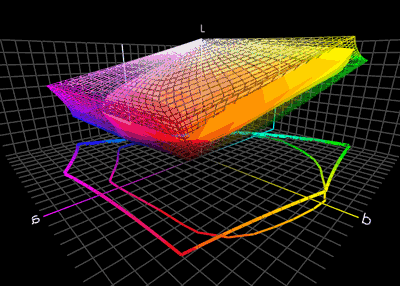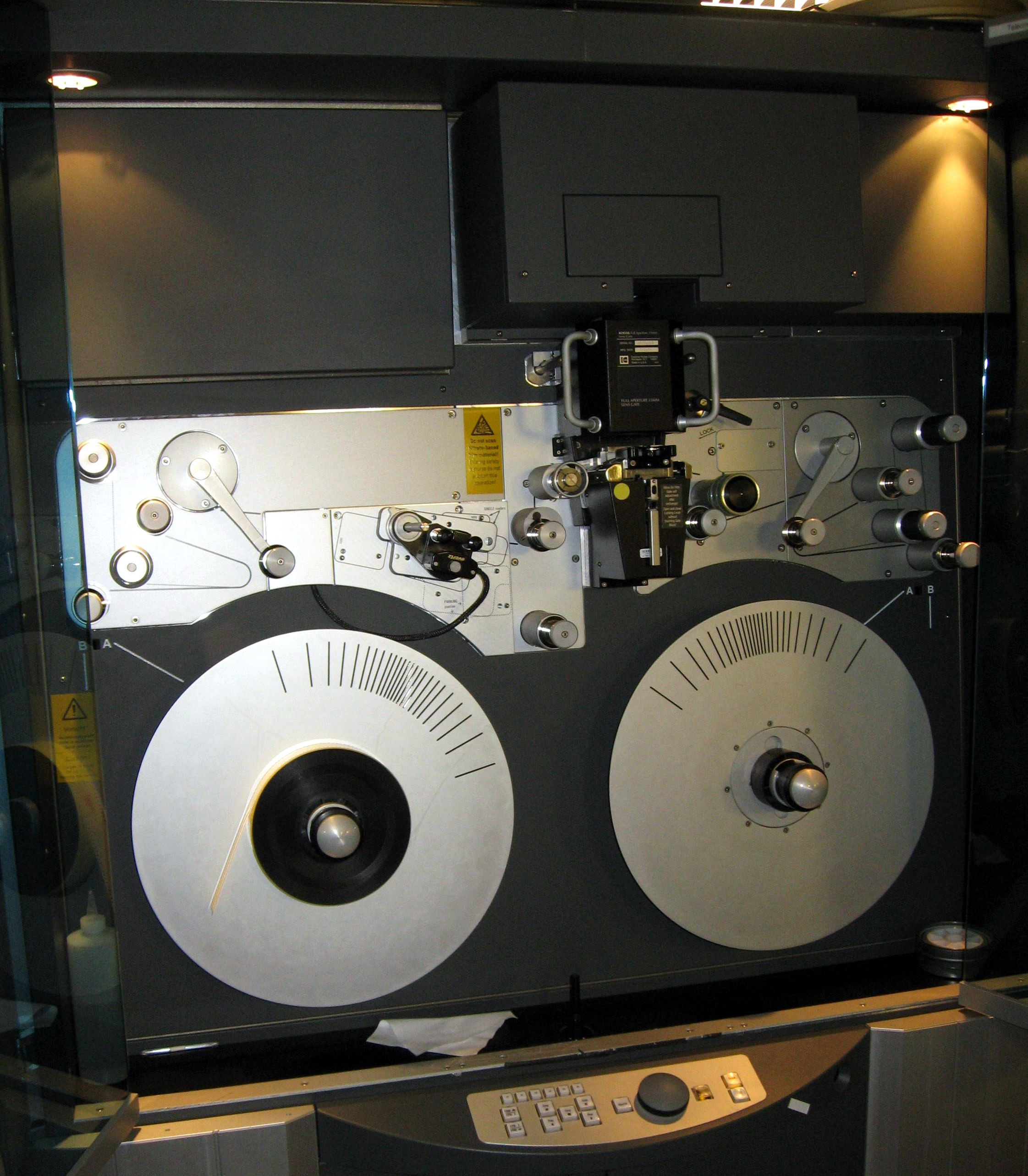|
ASC CDL
The American Society of Cinematographers Color Decision List (ASC CDL) is a format for the exchange of basic primary color grading information between equipment and software from different manufacturers. The format defines the math for three functions: Slope, Offset and Power. Each function uses a number for the red, green, and blue color channels for a total of nine numbers comprising a single color decision. A tenth number, Saturation, specified in the Version 1.2 release, applies to the R, G, and B color channels in combination. The ASC CDL was developed by the ASC Technology Committee, a combined group of cinematographers, post-production engineers, and other motion picture industry professionals. Although the basic controls of most color correction systems are similar, they differ somewhat in specific implementation and detail. The ASC CDL is a common standard that color correctors can translate their proprietary settings to and from. The ASC CDL functions are mathematically o ... [...More Info...] [...Related Items...] OR: [Wikipedia] [Google] [Baidu] |
American Society Of Cinematographers
The American Society of Cinematographers (ASC), founded in Hollywood in 1919, is a cultural, educational, and professional organization that is neither a labor union nor a guild. The society was organized to advance the science and art of cinematography and gather a wide range of cinematographers to discuss techniques and ideas and to advocate for motion pictures as a type of art form. Currently, the president of the ASC is Stephen Lighthill. Members use the post-nominal letters "ASC". On the 1920 film titled ''Sand'', cinematographer Joseph H. August, who was an original member of the ASC, became the first individual to have the "ASC" appear after his name on the onscreen credit. Only film cinematographers and special effect supervisors can become an ASC member. Basic requirements include being a director of photography for a minimum five out of the last eight years, having a high professional reputation and being recommended by three active or retired ASC members. History ... [...More Info...] [...Related Items...] OR: [Wikipedia] [Google] [Baidu] |
Color Management
In digital imaging systems, color management (or colour management) is the controlled conversion between the color representations of various devices, such as image scanners, digital cameras, monitors, TV screens, film printers, computer printers, offset presses, and corresponding media. The primary goal of color management is to obtain a good match across color devices; for example, the colors of one frame of a video should appear the same on a computer LCD monitor, on a plasma TV screen, and as a printed poster. Color management helps to achieve the same appearance on all of these devices, provided the devices are capable of delivering the needed color intensities. With photography, it is often critical that prints or online galleries appear how they were intended. Color management cannot guarantee identical color reproduction, as this is rarely possible, but it can at least give more control over any changes which may occur. Parts of this technology are implemented in the ope ... [...More Info...] [...Related Items...] OR: [Wikipedia] [Google] [Baidu] |
The Hollywood Reporter
''The Hollywood Reporter'' (''THR'') is an American digital and print magazine which focuses on the Hollywood film, television, and entertainment industries. It was founded in 1930 as a daily trade paper, and in 2010 switched to a weekly large-format print magazine with a revamped website. As of 2020, the day-to-day operations of the company are handled by Penske Media Corporation through a joint venture with Eldridge Industries. History Early years; 1930–1987 ''The Hollywood Reporter'' was founded in 1930 by William R. "Billy" Wilkerson (1890–1962) as Hollywood's first daily entertainment trade newspaper. The first edition appeared on September 3, 1930, and featured Wilkerson's front-page "Tradeviews" column, which became influential. The newspaper appeared Monday-to-Saturday for the first 10 years, except for a brief period, then Monday-to-Friday from 1940. Wilkerson used caustic articles and gossip to generate publicity and got noticed by the studio bosses in New Yor ... [...More Info...] [...Related Items...] OR: [Wikipedia] [Google] [Baidu] |
SMPTE
The Society of Motion Picture and Television Engineers (SMPTE) (, rarely ), founded in 1916 as the Society of Motion Picture Engineers or SMPE, is a global professional association of engineers, technologists, and executives working in the media and entertainment industry. As an internationally recognized standards organization, SMPTE has published more than 800 technical standards and related documents for broadcast, filmmaking, digital cinema, audio recording, information technology (IT), and medical imaging. SMPTE also publishes the ''SMPTE Motion Imaging Journal'', provides networking opportunities for its members, produces academic conferences and exhibitions, and performs other industry-related functions. SMPTE membership is open to any individual or organization with an interest in the subject matter. In the US, SMPTE is a 501(c)3 non-profit charitable organization. History The Motion Picture and Television Engineers was founded in 1913 by Charles Francis Jenkins ... [...More Info...] [...Related Items...] OR: [Wikipedia] [Google] [Baidu] |
Clark, Curtis
Curtis Clark (born 23 April 1950) is a jazz pianist from Chicago, United States. Clark was born in Chicago, Illinois in 1950, but moved to Los Angeles where he spent his student years and started composing and playing the piano. After Clark graduated in music theory and composition from the California Institute of Arts in Valencia, he set out for New York City. There he began working and recording with David Murray. Influenced by Miles Davis, Duke Ellington, Horace Tapscott, Thelonious Monk and John Coltrane, Clark was based in Amsterdam for many years until his return to the U.S. He is now situated in New England. While working with various groups, Clark has played with musicians including Oscar Brown, Jr., Julian Priester, Art Taylor, Billy Bang, Richard Davis, Abbey Lincoln, Charles Tyler, John Tchicai and Han Bennink. He was a National Patron of Delta Omicron, an international professional music fraternity. [...More Info...] [...Related Items...] OR: [Wikipedia] [Google] [Baidu] |
American Cinematographer
''American Cinematographer'' is a magazine published monthly by the American Society of Cinematographers. It focuses on the art and craft of cinematography, covering domestic and foreign feature productions, television productions, short films, music videos and commercials. The emphasis is on interviews with cinematographers, but directors and other filmmakers are often featured as well. Articles include technical how-to pieces, discussions of tools and technologies that affect cinematography, and historical features. History The American Society of Cinematographers was founded in 1919. It began publishing ''American Cinematographer'' on November 1, 1920, as a twice-monthly four-page newsletter about the ASC and its members. In 1922, the publication went monthly. In 1929, editor Hal Hall started to change the publication; he reformatted it to standard magazine size, increased the page count, and included more articles on amateur filmmaking. For a while during the 1930s, the magazin ... [...More Info...] [...Related Items...] OR: [Wikipedia] [Google] [Baidu] |
Variety (magazine)
''Variety'' is an American media company owned by Penske Media Corporation. The company was founded by Sime Silverman in New York City in 1905 as a weekly newspaper reporting on theater and vaudeville. In 1933 it added ''Daily Variety'', based in Los Angeles, to cover the motion-picture industry. ''Variety.com'' features entertainment news, reviews, box office results, cover stories, videos, photo galleries and features, plus a credits database, production charts and calendar, with archive content dating back to 1905. History Foundation ''Variety'' has been published since December 16, 1905, when it was launched by Sime Silverman as a weekly periodical covering theater and vaudeville with its headquarters in New York City. Silverman had been fired by '' The Morning Telegraph'' in 1905 for panning an act which had taken out an advert for $50. As a result, he decided to start his own publication "that ouldnot be influenced by advertising." With a loan of $1,500 from his f ... [...More Info...] [...Related Items...] OR: [Wikipedia] [Google] [Baidu] |
Telecine
Telecine ( or ) is the process of transferring film into video and is performed in a color suite. The term is also used to refer to the equipment used in the post-production process. Telecine enables a motion picture, captured originally on film stock, to be viewed with standard video equipment, such as television sets, video cassette recorders (VCR), DVD, Blu-ray Disc or computers. Initially, this allowed television broadcasters to produce programs using film, usually 16mm stock, but transmit them in the same format, and quality, as other forms of television production. Furthermore, telecine allows film producers, television producers and film distributors working in the film industry to release their productions on video and allows producers to use video production equipment to complete their filmmaking projects. Within the film industry, it is also referred to as a TK, because TC is already used to designate timecode. Motion picture film scanners are similar to telecines ... [...More Info...] [...Related Items...] OR: [Wikipedia] [Google] [Baidu] |
Colour Look-up Table
In computer graphics, a palette is the set of available colors from which an image can be made. In some systems, the palette is fixed by the hardware design, and in others it is dynamic, typically implemented via a color lookup table (CLUT), a correspondence table in which selected colors from a certain color space's color reproduction range are assigned an index, by which they can be referenced. By referencing the colors via an index, which takes less information than needed to describe the actual colors in the color space, this technique aims to reduce data usage, including processing, transfer bandwidth, RAM usage, and storage. Images in which colors are indicated by references to a CLUT are called indexed color images. Description As of 2019, the most common image colorspace in graphics cards is the RGB color model with 8 bits per pixel color depth. Using this technique, 8 bits per pixel are used to describe the luminance level in each of the RGB channels, therefore 24 b ... [...More Info...] [...Related Items...] OR: [Wikipedia] [Google] [Baidu] |
Color Grading
Color grading is a post-production process common to filmmaking and video editing of altering the appearance of an image for presentation in different environments on different devices. Various attributes of an image such as contrast, color, saturation, detail, black level, and white balance may be enhanced whether for motion pictures, videos, or still images. Color grading and color correction are often used synonymously as terms for this process and can include the generation of artistic color effects through creative blending and compositing of different layer masks of the source image. Color grading is generally now performed in a digital process either in a controlled environment such as a color suite, and is usually done in a dim or dark environment. The earlier photochemical film process, referred to as color timing, was performed at a film lab during printing by varying the intensity and color of light used to expose the rephotographed image. Since, with this proces ... [...More Info...] [...Related Items...] OR: [Wikipedia] [Google] [Baidu] |



.jpg)